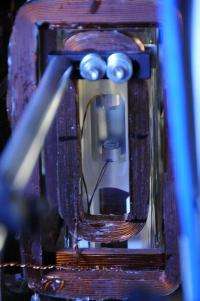No-photon laser: Physicists demonstrate 'superradiant' laser design

Physicists at JILA have demonstrated a novel "superradiant" laser design, which has the potential to be 100 to 1,000 times more stable than the best conventional visible lasers. This type of laser could boost the performance of the most advanced atomic clocks and related technologies, such as communications and navigation systems as well as space-based astronomical instruments.
Described in the April 5, 2012, issue of Nature, the JILA laser prototype relies on a million rubidium atoms doing a sort of synchronized line dance to produce a dim beam of deep red laser light. JILA is a joint institute of the National Institute of Standards and Technology and the University of Colorado Boulder (CU).
JILA/NIST physicist James Thompson says the new laser is based on a powerful engineering technique called "phased arrays" in which electromagnetic waves from a large group of identical antennas are carefully synchronized to build a combined wave with special useful features that are not possible otherwise.
"It's like what happens in the classical world but with quantum objects," Thompson explains. "If you line up lots of radio antennas that each emit an oscillating electric field, you can get all their electric fields to add up to make a really good directional antenna. In the same way, the individual atoms spontaneously form something like a phased array of antennas to give you a very directional laser beam."
An ordinary laser relies on millions of particles of light (photons) ricocheting back and forth between two mirrors, striking atoms in the lasing material and generating copies of themselves to build up intense light. Photons with synchronized wave patterns leak out of the mirrored cavity to form a laser beam. The laser frequency, or color, wobbles slightly because the mirrors are vibrating due to either the motion of atoms in the mirrors or environmental disturbances—which can be as subtle as people walking past the room or cars driving near the building.
That doesn't happen in the new JILA laser simply because the photons don't hang around long enough. The atoms are constantly energizing and emitting synchronized photons, but on the average, very few—less than one photon, in fact —stick around between the mirrors. This average, which scientists calculate indirectly based on the laser beam's output power, is just enough to maintain an oscillating electric field to sustain the atoms' synchronized behavior. Nearly all photons escape before they have a chance to become scrambled by the mirrors and disrupt the synchronized atoms—thus averting the very effect that causes laser frequency to wobble in a normal laser.
Thompson engineered a system that first traps the atoms in laser light between two mirrors and then uses other low-power lasers to tune the rate at which the atoms switch back and forth between two energy levels. The atoms emit photons each time their energy level drops. The atoms ordinarily would emit just one photon per second, but their correlated action boosts that rate 10,000-fold—making the light superradiant, Thompson says. This "stimulated emission" meets the definition of a laser (Light Amplification by the Stimulated Emission of Radiation).
"This superradiant laser is really, really dim—about a million times weaker than a laser pointer," Thompson says. "But it is much brighter than one would expect from the ordinary uncoordinated emissions from individual atoms."
Thompson's measurements show that the stability of the laser beam frequency is less than 1/10,000th as sensitive to mirror motion as in a normal optical laser. This result suggests the new approach might be used in the future to improve the best lasers developed at NIST as much as 1,000-fold. Just as important, such lasers might be moved out of the vibration-controlled laboratory environment to be used in real-world applications.
Despite its dim light, the extraordinary stability of the superradiant laser can be transferred by using it as part of a feedback system to "lock" a normal laser's output. The bright laser, potentially 100 to 1,000 times more stable than today's best lasers, could then be used in the most advanced atomic clocks to induce the atomic oscillations that are the pendulum ticks of super-accurate clocks. The added stability allows for a better match to the atoms' exact frequency, significantly boosting the precision of the clock. The improvement would extend to atomic clock-based technologies such as GPS, optical communications, advanced geodetic surveys and astronomy.
Thompson's work confirms predictions made several years ago by JILA/NIST Fellow Jun Ye and JILA/CU theorist Murray Holland, who is also a co-author of the new Nature paper. Thompson stresses that for the new laser design to achieve its highest potential stability and be of practical use, it will need to be re-created using different atoms, such as strontium, which are better suited for use in advanced atomic clocks.
As a nonregulatory agency of the U.S. Department of Commerce, NIST promotes U.S. innovation and industrial competitiveness by advancing measurement science, standards and technology in ways that enhance economic security and improve our quality of life.
More information: J.G. Bohnet, Z. Chen, J.M. Weiner, D. Meiser, M.J. Holland and J.K. Thompson. A steady state superradiant laser with fewer than one intracavity photon. Nature. Apr. 5, 2012. www.nature.com/nature/journal/ … ull/nature10920.html
Journal information: Nature
Provided by National Institute of Standards and Technology


















